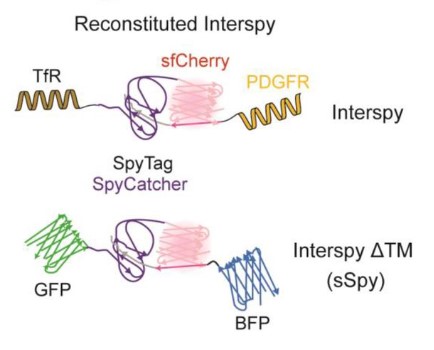Preprints by preLighters: Sonisilpa Mohapatra
9 May 2022
To accompany our interview with preLighter Soni Mohaptra, we spoke with her about her recent preprint describing InterSpy, a new synthetic biology tool.
Engineering functional membrane-membrane interface by InterSpy
, , , , , , ,
bioRxiv (2022) https://doi.org/10.1101/2022.04.04.487023
Could you tell us the main findings of your preprint?
In this preprint, we have introduced a novel engineered protein system called “InterSpy” that can be used to form membrane interfaces and to reconstitute split proteins. In the past, SpyTag/SpyCatcher peptide-protein pairs have been used for a variety of applications ranging from biopolymer production to vaccine development. We adapted this SpyTag/SpyCatcher system through fusion of appropriate transmembrane domains for expression of the protein system on the cellular membrane. Additionally, we integrated a split fluorescent protein system to help us track the formation of reconstituted functional fluorescent protein facilitated by the SpyTag-SpyCatcher bond formation through fluorescence imaging. We showed that this engineered protein module can be used to form membrane interfaces between cell membranes.
One of the other interesting aspects of this work is the demonstration of the usefulness of this synthetic biology toolkit in cell-free systems. Cell-free synthesis of the participating fragments of InterSpy in soluble or transmembrane forms allowed for functional reconstitution of split proteins on supported lipid bilayers and synthetic membrane interfaces. This could be of particular interest to protein engineers looking to evaluate and assess their protein designs in a rapid manner.
Why did you decide to preprint your work?
My own experiences as a researcher as well as those of my colleagues have shown me that the time from submitting a manuscript to a journal to getting it published can be long and arduous. I observe that many of the preprints posted on bioRxiv stay as preprints for a while before they are published. Pre-pandemic, I used to keep myself updated with ongoing research in the field through attending conferences. During the pandemic, preprints have become my major source of learning about new developments in the field. I look at preprints to update the community with one’s findings, while circumventing the red tape associated with traditional publishing.
While I am a strong proponent of preprinting, as a postdoctoral researcher I am usually not at the helm of making the decisions pertaining to preprinting. I am glad that our team decided to preprint our work and share it with others. I hope that others will find this work useful, while it is undergoing the formal review process.
What’s next to follow up on this work?
This work is part of the larger “Building a Synthetic Neuron” project. The technology that we have introduced here is applicable in both cellular and cell-free systems. In the future, we are interested in using this tool to reconstitute different protein systems, beyond fluorescent proteins. In our endeavor towards achieving bottom-up construction of a synthetic neuron, one can imagine a reconstituted “synthetic synapse” employing InterSpy wherein localized reconstitution of bioluminescence in cellular junctions of pre- and post-synaptic cells activates light-gated ion channels such as channel rhodopsins on the postsynaptic cell, leading towards the transduction of electrical signals.

Figure taken from the preprint: SpyTag/SpyCatcher assisted reconstitution of fluorescent sfCherry using transmembrane and soluble versions of InterSpy










